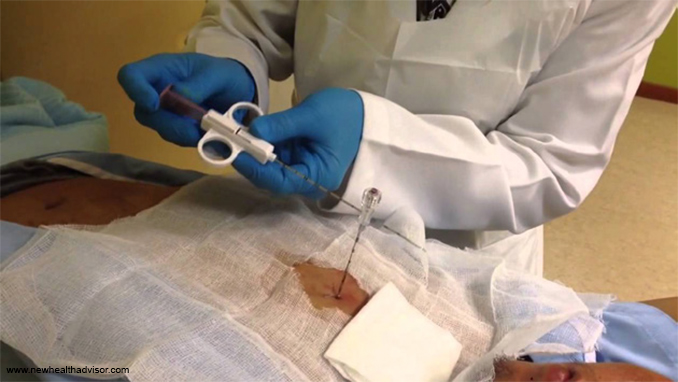What is a Lung Biopsy

A biopsy is a procedure performed to remove tissue or cells from the body for examination under a microscope. A lung biopsy is a procedure in which samples of lung tissue are removed (with a special biopsy needle or during surgery) to determine if lung disease or cancer is present
A lung biopsy may be performed using either a closed or an open method. Closed methods are performed through the skin or through the trachea (windpipe). An open biopsy is performed in the operating room under general anesthesia.
The various biopsy procedures include:
Needle biopsy After a local anesthetic is given, the doctor uses a needle that is guided through the chest wall into a suspicious area with computed tomography (CT or CAT scan) or fluoroscopy (a type of X-ray “movie”) to obtain a tissue sample. This type of biopsy may also be referred to as a closed, transthoracic, or percutaneous (through the skin) biopsy.
Transbronchial biopsyThis type of biopsy is performed through a fiberoptic bronchoscope (a long, thin tube that has a close-focusing telescope on the end for viewing) through the main airways of the lungs (bronchoscopy).
Thoracoscopic biopsy After a general anesthetic is given, an endoscope is inserted through the chest wall into the chest cavity. Various types of biopsy tools can be inserted through the endoscope to obtain lung tissue for examination. This procedure may be referred to as video-assisted thoracic surgery (VATS) biopsy. In addition to obtaining tissue for biopsy, therapeutic procedures, such as the removal of a nodule or other tissue lesion may be performed.
Open biopsy After a general anesthetic is given, the doctor makes an incision in the skin on the chest and surgically removes a piece of lung tissue. Depending on the results of the biopsy, more extensive surgery, such as the removal of a lung lobe may be performed during the procedure. An open biopsy is a surgical procedure and requires a hospital stay.
Other related procedures that may be used to help diagnose problems of the lungs and respiratory tract include chest X-ray, CT scan of the chest, magnetic resonance imaging (MRI), bronchoscopy, bronchography, chest fluoroscopy, chest ultrasound, lung scan, oximetry, mediastinoscopy, peak flow measurement, positron emission tomography (PET) scan, pulmonary function tests, pleural biopsy, pulmonary angiogram, sinus X-ray, and thoracentesis.
Anatomy of the respiratory system
The respiratory system is made up of the organs involved in the exchange of gases--primarily oxygen and carbon dioxide and consists of the:
- Nose
- Pharynx
- Larynx
- Trachea
- Bronchi
- Lungs
The upper respiratory tract includes the:
- Nose
- Nasal cavity
- Ethmoidal air cells
- Frontal sinuses
- Maxillary sinus
- Larynx
- Trachea
What are the functions of the lungs?
The lungs take in oxygen, which cells need to carry out their normal functions. The lungs also get rid of carbon dioxide, a waste product of the body's cells.
The lungs are a pair of cone-shaped organs made up of spongy, pinkish-gray tissue. They take up most of the space in the chest, or the thorax (the part of the body between the base of the neck and diaphragm).
The lungs are enveloped in a membrane called the pleura.
The lungs are separated from each other by the mediastinum, an area that contains the following:
- The heart and its large vessels
- Trachea (windpipe)
- Esophagus
- Thymus
- Lymph nodes
The right lung has three sections called lobes. The left lung has two lobes. When you breathe, the air enters the body through the nose or the mouth. It then travels down the throat through the larynx (voice box) and trachea (windpipe) and goes into the lungs through tubes called mainstem bronchi.
One mainstem bronchus leads to the right lung and one to the left lung. In the lungs, the mainstem bronchi divide into smaller bronchi and then into even smaller tubes called bronchioles. Bronchioles end in tiny air sacs called alveoli.
Reasons for the procedure
Reasons for which a lung biopsy may be performed include, but are not limited to, the following:
- To evaluate an abnormality seen on chest X-ray or CT scan
- To diagnose lung infection or other lung disease
- To investigate the cause of unexplained fluid collection in the lung
- To determine if a lung mass is malignant (cancerous) or benign
- To stage malignant tumors (determine the extent of spreading)
The type of biopsy performed will depend on several factors, such as the type of lung problem, the location of the lesion, and the overall condition of the person.
There may be other reasons for your doctor to recommend a lung biopsy.
Risks of the procedure
An open or thoracoscopic lung biopsy is a surgical procedure that is performed under general anesthesia. As with any surgical procedure, complications may occur. Some possible complications may include, but are not limited to, the following:
- Blood loss or clots
- Pain or discomfort
- Infection
- Pneumonia
A needle or transbronchial lung biopsy is performed under light sedation and/or local anesthesia. Some possible complications of these procedures may include, but are not limited to, the following:
- Pneumothorax is when air becomes trapped in the pleural space causing the lung to collapse
- Bleeding in the lung
- Infection
If you are pregnant, or suspect that you may be pregnant, you should notify your doctor.
If the biopsy is performed using an X-ray (CT or fluoroscopy), the amount of radiation used during the procedure is considered minimal; therefore, the risk for radiation exposure is very low.
There may be other risks depending on your specific medical condition. Be sure to discuss any concerns with your doctor prior to the procedure.